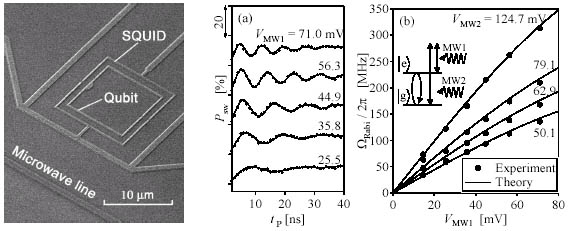Shiro Saito1, Masahito Ueda2, Hirotaka Tanaka1 and Kouichi Semba1
1Physical Science Laboratory, 2Tokyo Institute of Technology/NTT Research Professor
Quantum state engineering has become one of the most important areas
in quantum physics. In particular, the coherent control of quantum two-state
systems, which are applicable to quantum bits (qubits), has attracted increasing
interest in the context of quantum computing and quantum information processing.
Of the recently realized solid-state qubits, the superconducting flux qubit
has the advantages of scalability and a long coherence time. Multiphoton
transitions have been demonstrated in the flux qubit [1]. In this study,
we achieved the parametric control of a flux qubit by using two-frequency
microwave pulses [2]. We observed Rabi oscillations stemming from parametric
transitions between the qubit states when the sum of the two microwave
frequencies or the difference between them matched the qubit Larmor frequency
fqb.
Our device is fabricated by lithographic techniques that define the structure
of an inner aluminum loop forming a qubit and an outer enclosing dc-SQUID
loop for the readout (see Fig. 1). Two currents circulationg in opposite
directions in the qubit loop correspond to the ground state |g> and
an excited state |e> of the qubit. First a qubit operation is performed
by applying a two-frequency (fMW1 = 11.1 GHz, fMW2 = 18.5 GHz) microwave pulse of length tp to the qubit (fqb = 7.4 GHz). After the operation, we immediately apply a dc readout pulse
to the dc-SQUID and measure whether or not the SQUID switches to a voltage
state. By repeating the measurement 8000 times, we obtain the SQUID switching
probability Psw, which is directly related to the probability with which we find the qubit
in |e>. Figure 2(a) shows the microwave amplitude of the MW1 VMW1 dependence of Rabi oscillations when the microwave amplitude of the MW2
VMW2 is fixed at 50.1 mV. Figure 2(b) shows Rabi frequencies WRabi/2p at various VMW1 and VMW2 values, which are well reproduced by Rabi frequencies derived by using
a semiclassical model.
By utilizing the parametric processes, we can control a qubit with much higher frequencies than the qubit Larmor frequency. This implies that we can filter out the noise around and lower than the qubit frequency from the microwave line by using a high-pass filter. This will greatly improve qubit coherence.
[1] S. Saito, et al., Phys. Rev. Lett. 93 (2004) 037001.
[2] S. Saito, et al., Phys. Rev. Lett. 96 (2006) 107001.
 |
||||||
|
|
|||||